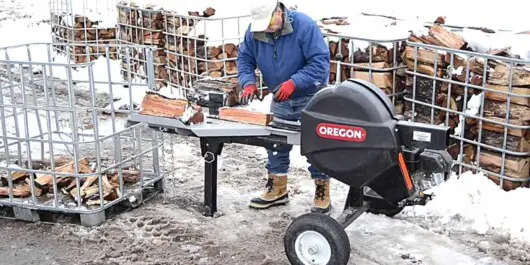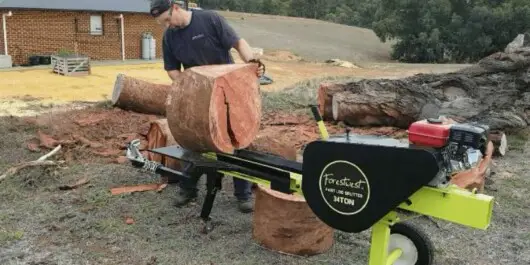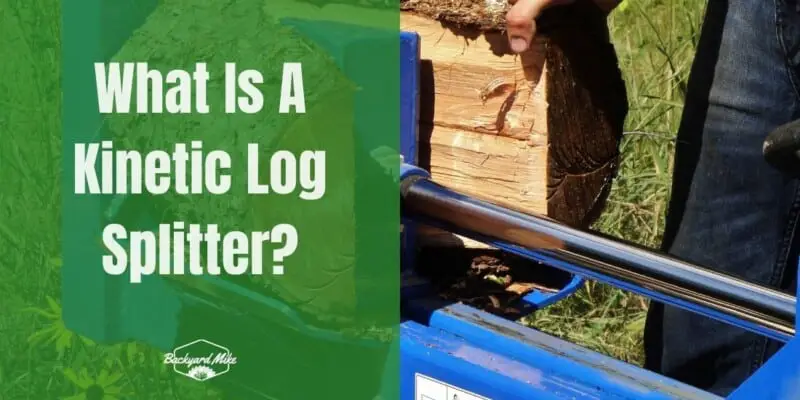Are you in the market for a machine to split wooden logs, but aren’t sure which one to go for because you don’t know about kinetic log splitters? If so, then you’ve just found yourself at the right place at the right time.
A kinetic log splitter is a machine that is used to split wood with kinetic energy. It has a motor that is connected to two flywheels. When you start the motor, it spins the flywheel and stores kinetic energy in the flywheels. Once you pull the handle, the energy will be released and the ram will shoot out at high speed, splitting the wooden logs.

In this article, you’ll get to know all about kinetic log splitters, what is a kinetic log splitter, why you should use a kinetic log splitter, important things to keep in mind when buying a kinetic log splitter, and more. Stick around to get all the answers that you’re looking for.
What is a kinetic log splitter?
Winter is almost here, and it’s that time of the year when you need to get the firewood ready. A high-quality log splitter will make work easier and more efficient, especially when you’re dealing with hardwood.
The log splitters that you normally see in the market are hydraulic log splitters. They make use of a hydraulic pump for pumping oil into a hydraulic cylinder. A hydraulic log splitter uses a hydraulic pump for pumping oil into a hydraulic cylinder, slowly pushing the splitting ram to split wooden logs. However, there’s another incredibly popular type of log splitter, and it is the kinetic log splitter.
The way a kinetic log splitter works is pretty simple. There’s a motor connected to two flywheels (one on each side) with a belt. When you start the motor, it spins the flywheel and stores kinetic energy in the spinning flywheels. Once you pull the handle, it’ll engage the rack and pinion system, which will work as a clutch. The energy will be released to the ram while the ram will short out at high speed, splitting the wooden logs with great force and speed. Interestingly, the cycle time will only be around 2-3 seconds.
Why you should be using a kinetic log splitter?
The biggest and most commonly considered reason for using a kinetic log splitter is its speed. A kinetic log splitter is incredibly fast. In fact, most log splitters have cycle times (the time that it takes for the splitter to split a log and return to its starting position) of around 2-3 seconds. When you compare it to the typical cycle time of hydraulic log splitters, these fall in the range of 12-15 seconds.
The reason for the high speed of kinetic log splitters is that the energy that drives a kinetic splitter gets built up by spinning the flywheels and it’s stored until the moment the machine’s operator releases it by moving a lever. Once the energy gets released, it’ll explode as a powerful, quick push of the ram. The splitter’s ram will then automatically return to its starting position.
You should remember that the high speed is essentially the reason that you won’t always get a tonnage rating for a kinetic splitter. Tonnage is essentially a measure of gradually applied pressure and it’ll be easier to measure on a slower-moving hydraulic log splitter. If you see a tonnage rating for a kinetic splitter, it’ll be calculated by comparing the machine’s splitting ability to the tonnage of a hydraulic unit.
You shouldn’t think that speed is the only benefit, though. Kinetic log splitters are also fairly easy to maintain. With kinetic splitters, there aren’t any parts like hydraulic hoses or pumps that you may need to replace. You’ll need to maintain the engine on gas-powered kinetic log splitters, just as you would for any other gas-powered equipment. However, kinetic log splitters come with fewer parts to worry about compared to hydraulic log splitters.
They also don’t require hydraulic fluid. Not only will hydraulic fluid have to be checked annually for contamination and drained periodically, but it can also sometimes leak, especially if a hydraulic log splitter’s hoses are worn down. Another benefit of using a gas-powered kinetic wood splitter is that it is incredibly energy-efficient and it uses less fuel compared to the hydraulic counterparts. While kinetic splitters have a ton of benefits to offer, in certain cases, a hydraulic log splitter could be the better choice.
Details to consider when purchasing a kinetic log splitter
One of the reasons that not everyone goes for a kinetic log splitter is the cost. Kinetic log splitters generally have a high price tag compared to hydraulic models. This can place them out of consideration for budged-minded homeowners.
Kinetic log splitters will also lack the ability to easily shift into the vertical position. Certain hydraulic log splitters are a combination of horizontal/vertical splitters. When the splitters are turned vertically, they’ll offer users the option to split large logs without needing to lift them onto the splitter. Kinetic log splitters lack this option because of their consideration.
Lastly, kinetic log splitters work best with medium or soft woods like the wood from cone-bearing trees such as pine. Extremely dense hardwoods and woods that contain knots and other abnormalities often present challenges for kinetic log splitters. With harder woods, you might have to attempt the split more than once for getting through the wooden logs. However, as kinetic log splitters are so fast, this process could take less time compared to one hydraulic cycle.
Who will benefit the most from using a kinetic log splitter?
As it is often said, time is money and the speed of kinetic log splitters makes them extremely appealing for firewood sellers and commercial users who have to split wood quickly to maximize their sales volume. The price point of kinetic log splitters makes them a natural fit for the commercial market too.
However, anyone who is looking to spend less time splitting firewood and more time enjoying it by sitting beside the roaring fire will benefit from a kinetic log splitter.
The most appealing part of a kinetic log splitter is that it is much, much faster than other types of hydraulic log splitters. You’ll no longer have to sit around and wait for the ram to go out and back slowly. Now, you only have to put the log on the log splitter, pull the handle, and before you can put another one on, the ram will return already and be ready for the next split, saving you a lot of valuable time.
There are a few hidden benefits of using a kinetic log splitter for interested users –
Minimum maintenance required
The maintenance required will be minimum. All you’ll have to do is keep your log splitter clean and lubricate the gears as it’ll grant you years of usage. Moreover, there won’t be any oil or pump issues.

Kinetic log splitters can outsplit other types of log splitters
If you’re having a really tough piece of wood that cannot be split on the first attempt, you’ll likely need to split it using a kinetic log splitter. A kinetic log splitter makes use of a thrust to crush the logs whereas the hydraulic log splitter is only capable of generating a steady force. Therefore, a kinetic log splitter can always outsplit any hydraulic log splitter of the same level.
Conclusion
Thank you for reading. Hopefully, now you know a lot more about kinetic log splitters, what is a kinetic log splitter, why you should use a kinetic log splitter, important things to keep in mind when buying a kinetic log splitter, and more. Kinetic log splitters are the type of log splitters that make use of a hydraulic pump to pump oil into the hydraulic cylinder. A kinetic log splitter will slowly push the splitting ram to help you split wooden logs. Most log splitters that you’ll come across in the market are hydraulic log splitters. These are extremely versatile and can work on most types of wood, even hardwood like stringy bark, red gum, yellow box, jarrah, ironbark, blackwood, and more. With enough time and research, you’ll be able to find a kinetic log splitter that can suit your need.


